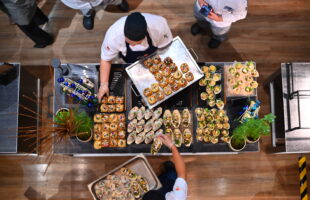
Companies will be rolling out healthy food that's easy to prepare and convenient to consume this year. Courtesy of WGSN
Supporting holistic health and wellness continue to be at the forefront of trends in the food and beverage (F&B) industry, with the COVID-19 pandemic still a key driver. The consumers of today have gone through this mentally and physically stressful time, resulting in a hyperfocus on self-care through nutrition.
They are aware of the link between the food they consume and their health, and want to be more proactive in taking care of themselves and their loved ones. Making more mindful choices while still making consumption an enjoyable experience is of importance. They want to understand what they eat and drink, and what effects these have on their overall well-being.
These shifting lifestyle demands and the emphasis on purposeful indulgence should be taken into consideration by manufacturers and companies in F&B. It pays to take a consumer-centric approach when thinking of new offerings, and businesses need to quickly adapt to the evolving consumer needs. Customers will cater to products that are relevant and will resonate to their priorities.
Convenient, healthy food
According to the Innova Market Insights survey, 76% of global consumers aged 26 to 55 believe healthy ageing starts with the food consumed. In particular, Asia has a growing aging population so wellness through diet is top of mind. This heightened emphasis on health comes with a growing interest in gut health and its connection to the body’s immune function. Therefore, nutrient-dense whole foods and products that contain functional ingredients continue to take center stage.
As there is more education on the benefits of certain bacteria in the digestive system, food and drinks that feature fiber, pre-, pro- and postbiotics will continue to gain traction. These microbiome solutions can help reduce systemic inflammation, boosting overall immune functionality.
There is also a rise in accessible, convenient and functional food items that can be easily incorporated in everyday routines. For instance, herbal soups are becoming popular due to their benefits to the immune system. The preference is now on ready-to-eat and ready-to-drink variants of this product, over a broth packet that takes three hours to boil.
Relieving stress and improving sleep quality are imperative in the area of mental well-being. This is why products like the Yakult 1000, which contain the highest number of probiotics across the brand’s fermented milk beverages, is becoming an attractive choice.
Infusing products with healthy, functional ingredients and collaborating with academics and experts to do so is still the way to go.

Going back to local
Another trend that’s gaining ground and partially brought about by the pandemic and restrictions on mobility is utilising familiar, simple ingredients. More are seeking inspiration and are getting influenced by local flavours and raw materials unique to each region.
This trend began in the restaurant scene, where chefs are discovering forgotten flavours and utilising local sustainable and seasonal ingredients. Besides ingredients, ancient cooking methods are also being brought to the forefront. These practices will eventually influence the food processing sector as well.
It’s about embracing our own unique cultures and roots, seeking inspiration from our own histories and tapping local farms. Then incorporating personal expression and infusion, doing so provides diversity in lesser-known raw materials.
Additionally, traditionally Asian ingredients are being introduced into the West, repackaged, reconceptualised and translated into new formats for that market to consume. Common ingredients like Koji are considered “new” and “innovative” in that side of the world, gaining attraction from more experimental customers. In particular, this trend is seen in California and areas in the West Coast where there are a lot of disruptors and innovators in F&B.

Minimising social impact
While physical health and emotional well-being continue to take center stage, social impact and long-term environmental effects are being taken into consideration too. Consumers are willing to pay more for products that care for the plant and demonstrate sustainability.
Reducing greenhouse gas emissions, plastic wastage and turning to renewable sources of energy are practices looked upon favorably. Businesses must then show transparency in their sourcing and manufacturing processes, ensuring these are ethical and sustainable.
This is also why the plant-based and alternative protein segments are accelerating at a fast pace in the industry. These are considered “high-tech” foods and are packaged in familiar formats to increase awareness in the market. Creating and reinventing climate hero foods that use less water, energy and other natural resources will be seen even more
In particular, science-based innovation in F&B has seen a wider acceptance in Asia. India and China are more enthusiastic about cell-based meat, while Singapore is the first country to support the cultivated meat industry through government-led campaigns. And it seems to make sense as the whole concept of zero-waste and sustainability is familiar in a lot of Asian cultures.
“In fact, these kinds of practices have been ingrained in Asian culture for many, many years. It’s just that no one has been talking about it until this point,” Jess Tang, Senior Consultant of APAC at WGSN says. It’s a common practice to ensure that every part of a produce, animal or food item is utilised and not wasted. Asians have been doing this for generations, being conscious about their own practices and resources.
Beyond these trends, it’s important for players in F&B to have a deep understanding of what the target market is looking for. It’s about ensuring that your product offerings reflect these needs, so that growth opportunities are abundant in this new year.
Insights provided by Pan Hong, Vice President, Marketing Asia Pacific at ADM; and Jess Tang, Senior Consultant of APAC at WGSN.








